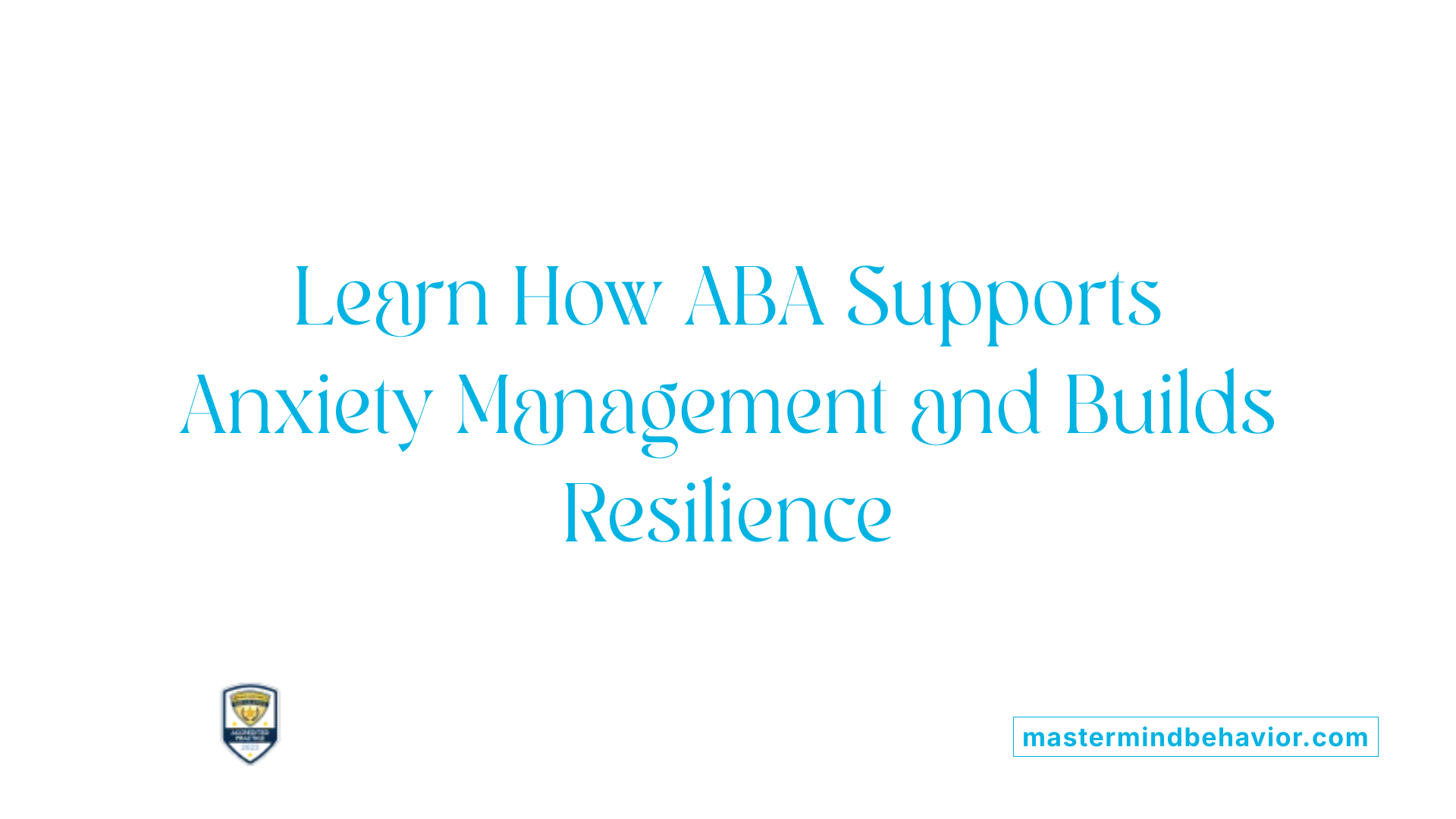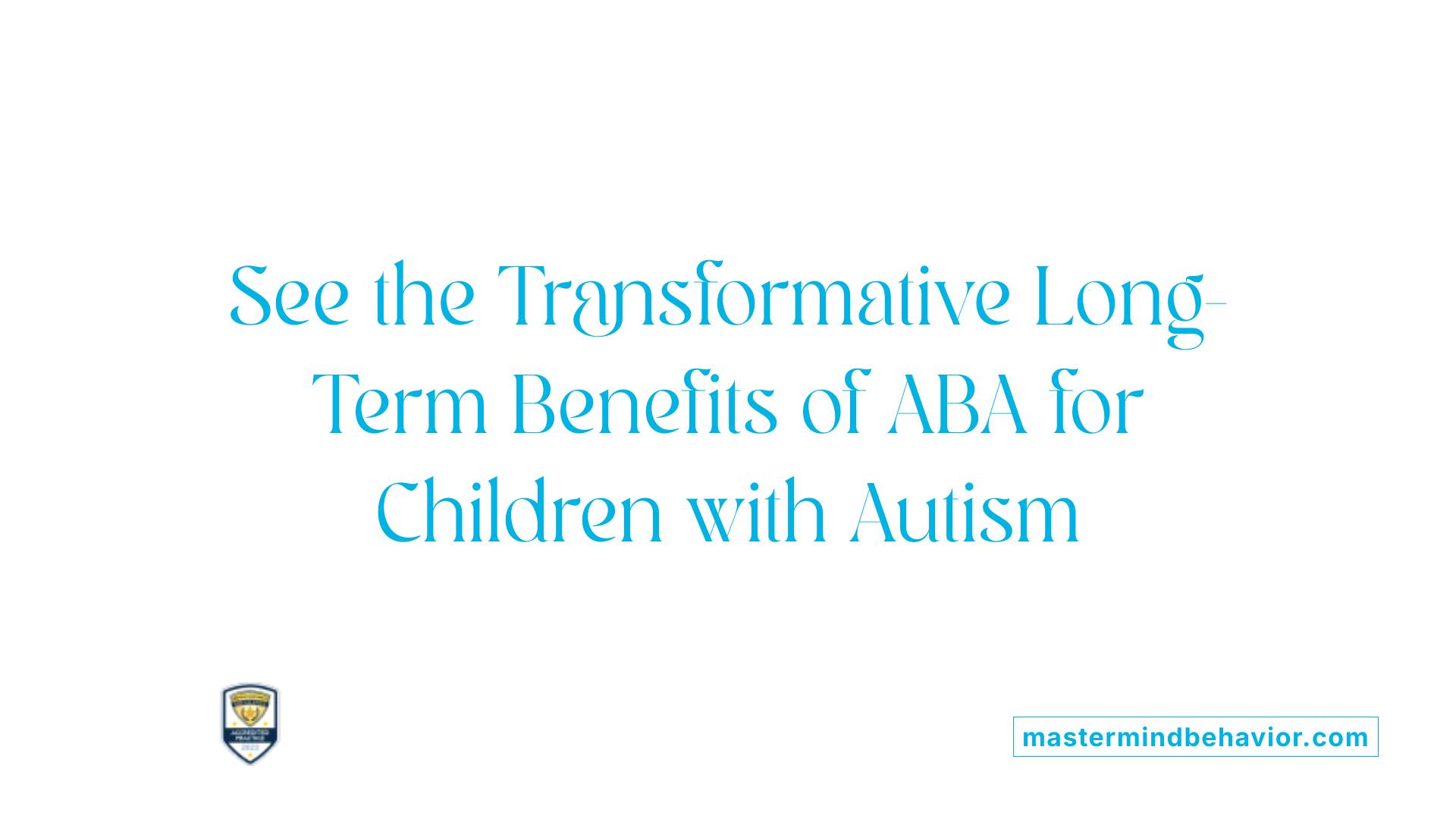ABA Therapy For Building Resilience To Change

Understanding the Role of ABA Therapy in Helping Children Navigate Change
Children with autism often face significant challenges in adapting to change due to sensory sensitivities, social difficulties, and emotional regulation issues. Applied Behavior Analysis (ABA) therapy offers evidence-based strategies to build resilience, equipping these children with the skills to cope with stress and embrace new situations more confidently. This article explores how ABA therapy promotes emotional regulation, communication, and adaptive behaviors essential for resilience to change, providing a framework for families, educators, and therapists committed to supporting children with autism.
Defining ABA Therapy: A Scientific Approach to Behavior and Learning

What is Applied Behavior Analysis (ABA) therapy?
Applied Behavior Analysis (ABA) therapy is a scientific method aimed at understanding behavior and learning by examining how behaviors interact with the environment. It focuses on increasing positive behaviors, including communication, social skills, and daily living abilities, while reducing harmful or disruptive behaviors.
Principles of learning underpinning ABA
ABA uses principles of learning such as positive reinforcement, where desired behaviors are encouraged by rewarding them. This scientifically grounded approach breaks complex skills into smaller steps and uses repeated practice and rewards to teach and strengthen these skills.
Individualization and evidence base
Each ABA program is tailored specifically to the child's needs following a thorough evaluation by a certified professional, often a Board Certified Behavior Analyst (BCBA). This personalized intervention ensures that treatment targets the unique behaviors and challenges of the individual. ABA is research-backed, demonstrating effectiveness particularly for children with autism spectrum disorder.
Therapeutic techniques used
ABA employs strategies such as discrete trial training, modeling, prompting, and naturalistic teaching. The therapy also involves caregivers to make sure progress extends beyond therapy, ensuring skills are generalized across settings like home and school. Overall, ABA therapy promotes independence and better quality of life by developing crucial behavioral, communication, and social skills through structured, science-based methods.
Core Principles Underlying ABA Therapy and Their Role in Building Resilience

What are the core principles behind ABA therapy?
Applied Behavior Analysis (ABA) therapy is rooted in operant conditioning, a learning theory that uses reinforcement and punishment to shape behavior. This approach relies on systematically identifying the Antecedents (A), Behaviors (B), and Consequences (C) of actions – known as the ABC model – to understand why behaviors happen and how to modify them effectively.
ABA practitioners emphasize positive reinforcement as a fundamental strategy. This means rewarding desired behaviors to increase their likelihood, helping children with autism develop skills in communication, social interaction, and daily living. For example, offering tangible rewards, praise, or access to preferred activities motivates learning and behavior change.
The therapy also uses techniques like prompting and prompt fading to guide skills acquisition, behavior chains to teach sequences of actions, and extinction procedures to decrease unwanted behaviors. These strategies are applied flexibly and tailored individually to each child’s unique profile and needs.
Personalization is central to ABA's effectiveness. Therapists assess each child's abilities and challenges and design interventions accordingly, ensuring supports match their environment and developmental goals. By breaking complex behaviors into manageable steps and reinforcing progress consistently, ABA promotes resilience by enabling children to adapt, cope, and thrive.
Ultimately, ABA therapy fosters independence and improves quality of life through well-structured, evidence-based approaches that build essential behavioral skills and empower children to navigate everyday challenges.
How ABA Therapy Supports Emotional Regulation and Coping Skills
Teaching Emotional Literacy with Visual Aids
ABA therapy incorporates visual aids such as picture cards and social stories to help children with autism recognize and understand their emotions. These tools facilitate emotional literacy by making abstract feelings more concrete and easier to identify, which is essential for emotional regulation.
Calming Techniques: Deep Breathing and Mindfulness
ABA therapists teach children calming techniques like deep breathing exercises and mindfulness practices. These methods are used during therapy sessions and can be practiced across home and school environments to help children manage stress and reduce anxiety effectively.
Creating Sensory-Friendly Environments
To reduce sensory overload, ABA therapy emphasizes the importance of sensory-friendly settings. These environments minimize triggers such as loud noises or bright lights, enabling children to feel safe and better regulate their emotions.
Developing Coping Skills: Problem-Solving and Relaxation
ABA strategies also include teaching problem-solving skills and relaxation techniques tailored to each child’s needs. Engaging children in their special interests is encouraged to promote stress relief. Additionally, ABA supports children in seeking help from trusted adults as part of their coping skill development.
These approaches rely on the principles of positive reinforcement, breaking down skills into manageable steps, and consistent practice. With continual support from therapists and families, children with autism build resilience by improving their emotional regulation and coping mechanisms through ABA therapy.
Enhancing Communication and Social Skills Through ABA
Social skills groups and role-playing
ABA therapy often incorporates social skills groups that provide structured opportunities for children with autism to practice interactions in a supportive setting. Role-playing various social scenarios helps children rehearse appropriate responses, enabling them to better manage real-life social situations.
Visual communication aids such as picture cards and apps
Visual supports are vital tools within ABA for enhancing communication. Picture cards and specialized apps serve as alternative or augmentative communication methods, allowing children to express needs, thoughts, and feelings clearly, thus reducing frustration and promoting independence.
Teaching conversation initiation and maintenance
ABA techniques systematically teach children how to start and maintain conversations. Through modeling, prompting, and reinforcement, children learn key social exchanges like greetings, asking questions, and responding, building their confidence in social engagement.
Promoting social participation and confidence
By breaking down social skills into manageable steps, ABA encourages children to gradually increase social participation. Positive reinforcement and consistent practice promote self-esteem and help children feel more comfortable and confident in interacting with peers and adults alike.
Individualized Behavioral Assessments and Tailored Interventions
What is Functional Behavior Assessment (FBA)?
Functional Behavior Assessment, or FBA, is a foundational process in Applied Behavior Analysis (ABA) therapy. It involves systematically observing and analyzing a child's behavior to understand the underlying reasons—or functions—behind it. This may include identifying triggers, consequences, or environmental factors that maintain the behavior.
How Are Behavioral Triggers and Functions Understood?
ABA therapists look closely at how the environment interacts with behavior. For instance, a child might display aggression to escape a challenging task or to gain access to a preferred activity. By pinpointing these triggers and the purpose that behavior serves, therapists can develop more effective strategies.
Developing and Implementing Treatment Plans Based on Assessments
Following the FBA, therapists create individualized treatment plans tailored to the child's unique needs. These plans focus on promoting positive behaviors while reducing challenging ones. They may involve teaching alternative communication methods or adjusting routines to provide predictability.
Breaking Skills into Smaller, Teachable Components
To help a child learn new skills efficiently, ABA breaks complex behaviors down into manageable steps. Each component is practiced systematically, often with meaningful rewards for progress. This approach simplifies learning and builds confidence gradually.
This structured, customized approach ensures interventions address the root causes of behaviors and support meaningful skill development for children with autism.
The Critical Role of Family and Caregiver Involvement in ABA Therapy

Training Caregivers to Apply ABA Techniques
Family members and caregivers play a pivotal role in ABA therapy by learning how to implement behavioral strategies effectively. Professionals like Board Certified Behavior Analysts (BCBAs) train caregivers to understand and apply techniques such as reinforcement and prompting. This training ensures that therapeutic interventions continue consistently beyond clinic sessions.
Consistency and Reinforcement Beyond the Clinical Setting
ABA therapy’s success depends heavily on extending consistent reinforcement and practice into the child’s daily environment. Families provide routine support and repetition, which help children generalize new skills from therapy to home, school, and community settings. This consistency greatly improves skill retention and behavioral outcomes.
Parental Data Collection and Progress Monitoring
Parents and caregivers are actively involved in tracking the child's progress by collecting observational data. This information is vital for therapists to analyze behavior patterns, evaluate the effectiveness of interventions, and make timely adjustments. Collaborative data collection fosters transparency and empowers families to participate in treatment decisions.
Collaborative Approach with Therapists and Educators
Effective ABA therapy requires close collaboration between families, therapists, and educators. This teamwork promotes a unified approach to a child's development, aligning goals across settings and ensuring all adults interacting with the child use consistent strategies. Such cooperation maximizes the child’s opportunities to practice skills and receive reinforcement throughout their day.
Who Typically Provides ABA Therapy Services?
ABA services are delivered by trained professionals, including BCBAs, licensed therapists, and specialists from autism-focused organizations. These experts assess the child's behavior and needs, then develop customized plans. Beyond administering therapy, they coach caregivers and educators to maintain consistency, supporting the child’s progress across various environments.
| Aspect | Description | Importance |
|---|---|---|
| Caregiver Training | Teaching families to apply ABA strategies at home | Ensures skills generalize beyond therapy sessions |
| Consistency Across Settings | Repetition and reinforcement in multiple environments | Strengthens learning and behavior maintenance |
| Data Collection by Parents | Recording behavior and progress observations | Enables precise intervention adjustments |
| Collaborative Teamwork | Coordinated efforts among caregivers, therapists, and educators | Promotes uniformity in approach and supports child success |
| Professional Providers | Deliver ABA via assessments and individualized treatment plans | Provides expert guidance and evidence-based interventions |
ABA Therapy in Managing Anxiety and Encouraging Resilience to Change

How Does ABA Therapy Help Manage Anxiety in Children with Autism?
ABA therapy employs several effective strategies to help children with autism manage anxiety. Techniques such as deep breathing exercises and mindfulness are taught to provide calming effects during moments of stress. Sensory breaks—short periods where the child can retreat to a quiet and sensory-friendly environment—allow them to reset and reduce overwhelm. These methods help children develop practical coping skills to handle anxiety-inducing situations more effectively.
Why Are Predictable Routines and Safe Spaces Important?
Establishing predictable routines is a cornerstone of ABA therapy for children with autism. Consistent schedules help reduce anxiety by creating a sense of safety and predictability. Likewise, providing safe spaces where children can express emotions freely boosts resilience by encouraging emotional regulation. These environments encourage trust and openness, essential for adapting to change and bouncing back from setbacks.
What Does Success Look Like? Examples from ABA Therapy
Consider the case of a child who frequently exhibited aggressive behaviors to gain access to a favorite activity, such as using an iPad. Through ABA therapy, the child was taught requesting skills and routines that replaced aggression with appropriate communication. This intervention markedly reduced aggressive episodes and increased flexibility in the child's behavior, illustrating how ABA can foster resilience and adaptability.
How Does Behavior Management Link to Flexibility and Adaptability?
Behavioral management through ABA helps children break down complex challenges into manageable steps, promoting gradual mastery of new skills. Reinforcement techniques motivate children to practice these skills, whether it be social communication or emotional regulation. This stepwise approach encourages flexibility and adaptability by making change less overwhelming and more accessible, ultimately helping children thrive across multiple settings like home and school.
Long-Term Benefits of ABA Therapy for Children with Autism

How does ABA therapy benefit individuals with autism?
ABA therapy provides comprehensive benefits tailored to each individual's unique needs. By focusing on teaching essential skills such as communication, social interaction, self-care, and academic abilities, ABA helps children with autism improve their ability to function effectively in everyday life. The therapy employs positive reinforcement and environmental adjustments to encourage desirable behaviors and reduce challenging ones.
Enhancements in social skills and communication
ABA therapy excels in developing communication skills using modeling, prompting, and reinforcement strategies. Children learn to initiate and maintain conversations and engage in social interactions more comfortably. This progress opens doors for better relationships and community involvement.
Increased independence and daily living skills
A major focus of ABA is fostering independence by breaking complex behaviors into manageable steps. Skills like self-care, decision-making, and coping strategies become attainable goals, empowering children to navigate daily tasks confidently.
Improved academic performance and community participation
ABA's structured approach supports academic learning by targeting foundational skills necessary for classroom success. It also promotes generalization, ensuring skills learned in therapy transfer to school and community environments, leading to better participation and inclusion.
Sustained resilience and emotional well-being into adulthood
By equipping children with coping methods, emotional regulation techniques, and problem-solving skills, ABA prepares them to manage stress and adapt to change effectively. This foundation supports long-term emotional health and resilience, carrying benefits into adult life.
| Benefit Area | Key Focus | Long-Term Impact |
|---|---|---|
| Social Skills & Communication | Modeling, prompting, positive reinforcement | Enhanced interpersonal relationships and social inclusion |
| Independence | Breaking tasks into steps, self-care skills | Increased autonomy and confidence in daily activities |
| Academic & Community | Skill generalization, structured learning | Better school performance and wider community involvement |
| Emotional Well-Being | Coping strategies, emotional regulation | Sustained resilience and adaptability in adulthood |
Building Resilience and Embracing Change Through ABA Therapy
ABA therapy offers a comprehensive, evidence-based framework to empower children with autism to navigate change with greater emotional strength and adaptive skills. By blending scientifically grounded techniques with individualized, family-oriented approaches, ABA helps these children develop vital communication, social, and coping skills that foster resilience. Supporting children through predictable routines, skill-building exercises, and positive reinforcement, ABA therapy not only reduces challenging behaviors but also promotes confidence and independence. As these foundational skills strengthen, children become better equipped to face the uncertainties inherent in growth and change, ultimately improving their quality of life and opportunities for meaningful participation in community and school settings.
References
- Building Resilience in Children with Autism - Childwise ABA
- Expert Q&A: How ABA therapy can help with severe ...
- Applied Behavioral Analysis (ABA) - Bolingbrook
- How ABA Therapy Supports Behavioral Change
- Applied Behavior Analysis (ABA)
- The Science of ABA: Understanding the Principles ...
- What Is Applied Behavior Analysis - Exploring ABA ...
- Applied Behavior Analysis (ABA)
Recent articles

ABA Therapy Strategies For Developing Resilience To Criticism
Building Emotional Strength: ABA Approaches to Nurturing Resilience in Children with Autism

ABA Therapy For Building Resilience To Change
Harnessing ABA Therapy to Foster Adaptability and Emotional Strength in Children with Autism

Teaching Planning And Organization With ABA Tools
Enhancing Independence Through Structured ABA Strategies

Teaching Planning And Sequencing Using ABA Therapy
Enhancing Learning and Life Skills Through ABA-Based Planning and Sequencing

How ABA Therapy Encourages Healthy Risk Assessment Skills
Enhancing Decision-Making and Safety Awareness Through ABA Therapy

How ABA Therapy Improves Classroom Group Participation
Enhancing Classroom Dynamics Through Applied Behavior Analysis



